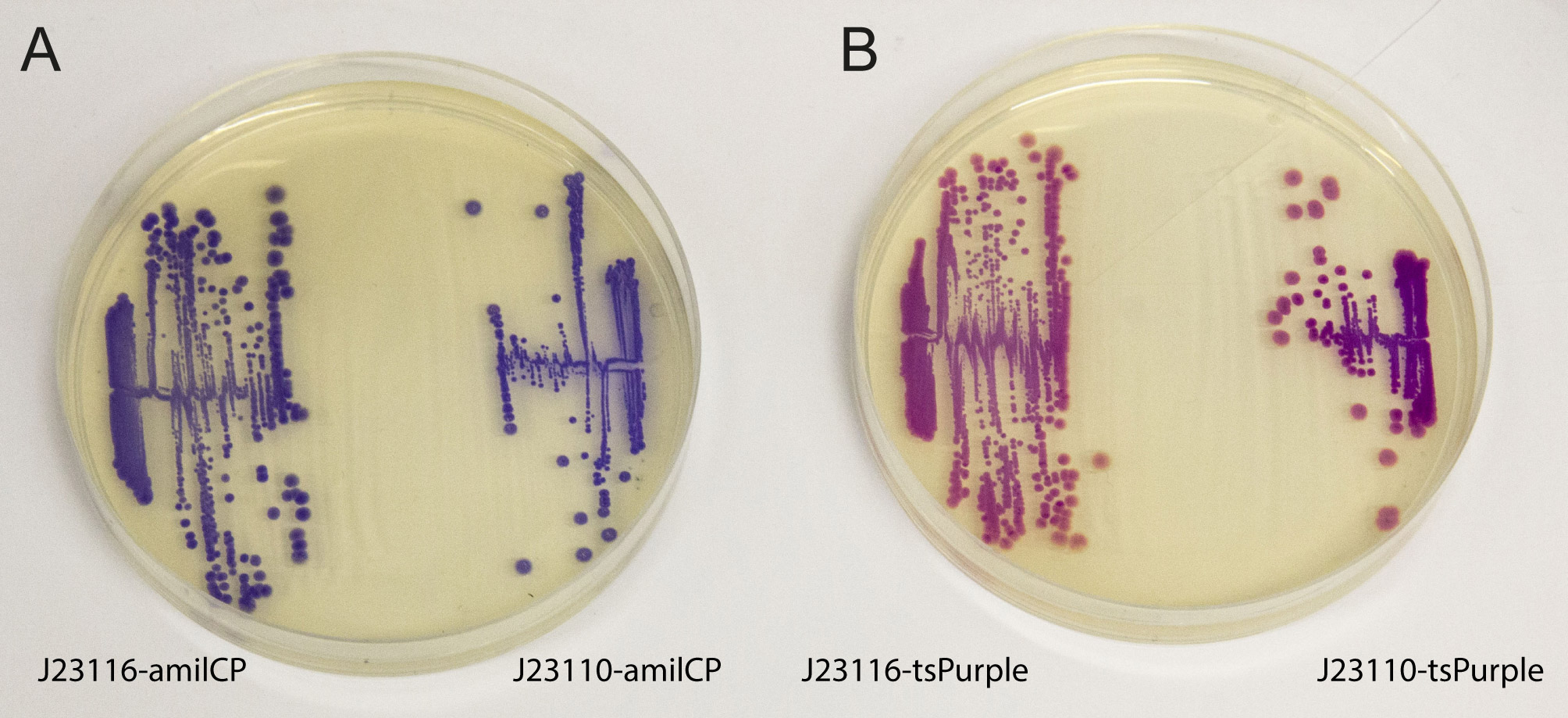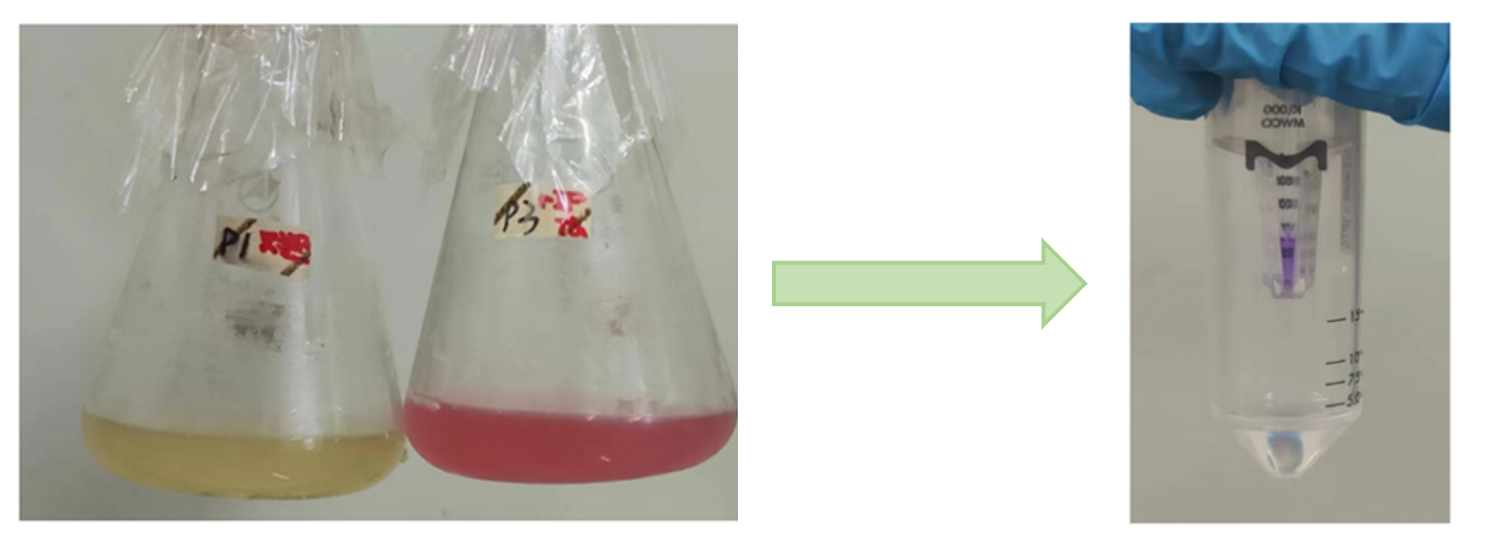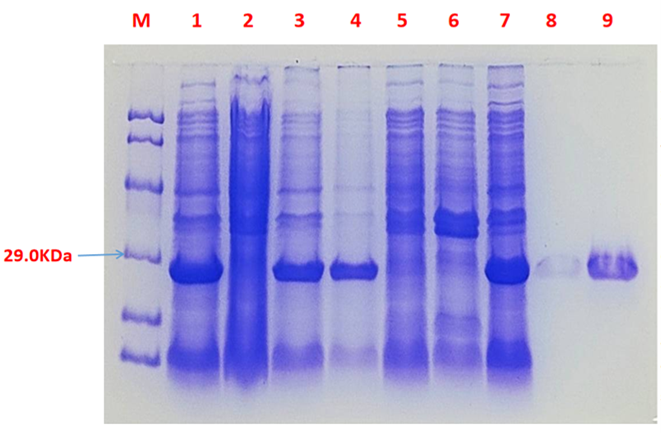Difference between revisions of "Part:BBa K1033905"
YuBo Zheng (Talk | contribs) |
YuBo Zheng (Talk | contribs) |
||
| Line 50: | Line 50: | ||
Conclusion: The protein gel preliminarily proved that the molecular mass of the tsPurple protein was correct, which is consistent with the expected molecular mass of tsPurple protein (the molecular mass of amajLime protein is about 26.9 kDa). Compared with lane 5, 6 and 7, lane 1, 2,3 and 4 indicate that more tsPurple protein can be obtained with IPTG induction. As is shown in lane 8, the concentration of protein was increased after ultrafiltration concentration. Lane 9 shows that the purification effect of protein after nickel affinity chromatography was better, and the impurity protein was less than before affinity chromatography. In conclusion, it can be seen that our expression and purification strategy is effective. | Conclusion: The protein gel preliminarily proved that the molecular mass of the tsPurple protein was correct, which is consistent with the expected molecular mass of tsPurple protein (the molecular mass of amajLime protein is about 26.9 kDa). Compared with lane 5, 6 and 7, lane 1, 2,3 and 4 indicate that more tsPurple protein can be obtained with IPTG induction. As is shown in lane 8, the concentration of protein was increased after ultrafiltration concentration. Lane 9 shows that the purification effect of protein after nickel affinity chromatography was better, and the impurity protein was less than before affinity chromatography. In conclusion, it can be seen that our expression and purification strategy is effective. | ||
<Br> | <Br> | ||
| − | [[Image:ts_T|500px|center]] | + | [[Image:ts_T.png|500px|center]] |
Fig. 4 concentration of the tsPurple protein samples<Br> | Fig. 4 concentration of the tsPurple protein samples<Br> | ||
Conclusion:We used the ultramicro spectrophotometer to measure the concentration of tsPurple protein. The concentration of tsPurple samples was 0.7533 mg/ml | Conclusion:We used the ultramicro spectrophotometer to measure the concentration of tsPurple protein. The concentration of tsPurple samples was 0.7533 mg/ml | ||
<Br> | <Br> | ||
Revision as of 18:12, 11 October 2022
tsPurple, purple chromoprotein (incl RBS)
This chromoprotein (also known as TinselPurple) naturally exhibits strong color when expressed.
Usage and Biology
This part is useful as a reporter.
iGEM2013 Uppsala: The images above show E coli constitutively expressing the chromoproteins amilCP BBa_K592009 and tsPurple BBa_K1033906 from the high copy plasmid pSB1C3 from the promoters J23116 and J23110.
Sequence and Features
- 10COMPATIBLE WITH RFC[10]
- 12COMPATIBLE WITH RFC[12]
- 21COMPATIBLE WITH RFC[21]
- 23COMPATIBLE WITH RFC[23]
- 25COMPATIBLE WITH RFC[25]
- 1000COMPATIBLE WITH RFC[1000]
Characterization
Team:NJTech_China 2022
Hoping to make a useful contribution for future iGEM teams,we completed the experimental characterization of existing parts tsPurple, purple chromoprotein(incl RBS) and meffBlue, blue chromoprotein and provided new documents for both of them.
The tsPurple sequence (Part:BBa_K1033905) optimized for E. coli was incorporated into plasmid pET-29a(+), transformed into E. coli BL21 for characterization and measurement. We provided tsPurple with results and data based on protein expression and purification, TOF-Mass spectrometry, and Swiss-model.
Methods:
SDS-PAGE, ultramicro spectrophotometer ,TOF-Mass Spectrometry, and Swiss-Model.
Results:
Fig.1 The fermentation broth of tsPurple Fig.2 Proteins after secondary ultrafiltration
Conclusion: The cell pellet was collected by harvesting 50mL culture after 24h of induction followed by centrifugation at 4 degrees and 6000 rpm for 10min. Then, we performed ultrasonic disruption and collected the supernatant after centrifugation. The protein was purified and collected through ultrafiltration and affinity chromatography.
Fig.3 SDS-PAGE of the chromoprotein tsPurple
1· tsPurple- The culture without IPTG induction.
2· tsPurple- Supernatant without IPTG induction after sonication.
3· tsPurple- The sedimentation without IPTG induction and after sonication.
4· tsPurple- Supernatant sample without IPTG induction after sonication.
5· tsPurple- The sedimentation after IPTG induction and ultrasound.
6· tsPurple- The culture after IPTG induction.
7· tsPurple- Protein sample after the ultrafiltration (diluted 5 times).
8. tsPurple- Protein after GST affinity chromatography.
9· tsPurple- Purified protein sample.
Conclusion: The protein gel preliminarily proved that the molecular mass of the tsPurple protein was correct, which is consistent with the expected molecular mass of tsPurple protein (the molecular mass of amajLime protein is about 26.9 kDa). Compared with lane 5, 6 and 7, lane 1, 2,3 and 4 indicate that more tsPurple protein can be obtained with IPTG induction. As is shown in lane 8, the concentration of protein was increased after ultrafiltration concentration. Lane 9 shows that the purification effect of protein after nickel affinity chromatography was better, and the impurity protein was less than before affinity chromatography. In conclusion, it can be seen that our expression and purification strategy is effective.
Fig. 4 concentration of the tsPurple protein samples
Conclusion:We used the ultramicro spectrophotometer to measure the concentration of tsPurple protein. The concentration of tsPurple samples was 0.7533 mg/ml




